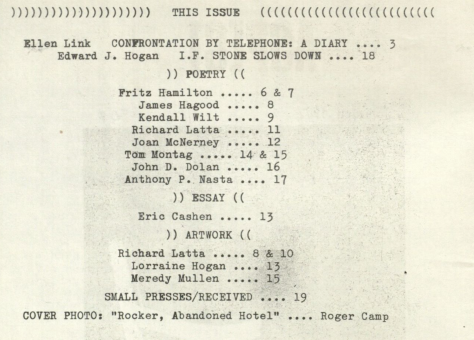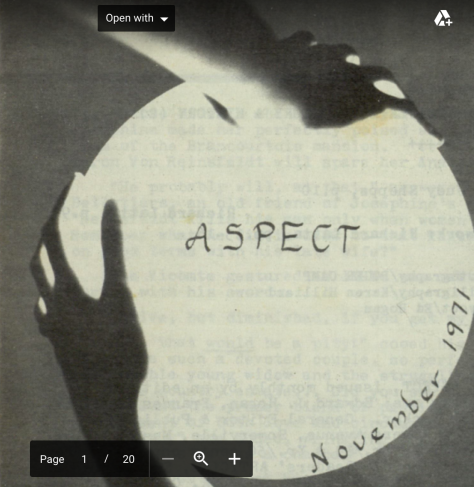
About a month ago we were writing metadata for issues of Aspect magazine. Working with our archivists Rodney and Zach, you were learning how to work with print materials in the archive. One of the interesting challenges for many of you was writing descriptive commentary. We then had a discussion in class about an image on the cover of the November 1971 issue of Aspect.

Following our conversation I received a letter from Seal Beach, California. The Letter from Roger Camp began by telling me that he had read notes from our discussion posted on our blog “regarding the cover photograph by Roger Camp. I enjoyed reading the comments and wanted to add my own since I took the photograph.” You will remember that I was asking us to distinguish between interpretive comments (about an image that “looked like a moon” to descriptive comments about an illuminated circle. Roger continued, “The woman in the photo was my wife and the ‘moon’ was a hanging lamp in the shape of a ball.”
Roger and I exchanged a couple of letters. In the Second Letter from Roger he shared some of his memories of working with Ed Hogan:
At that time, I used to send out about five photos at a time. They were 5×7 prints and labeled on the back with a title and my name and address. What people don’t realize is that the prints themselves were made to the same high standards as an art print which as a fine art photographer I would be making for exhibitions or gallery sales. I still have a few of those 5×7 prints in my files (in fact three different versions of the hands/light (moon) shot. Magazines at the time rarely returned photos even though I supplied them with SSAE. A couple of years ago I got in touch with the editor of Truck, one of the few journals of the 1970’s that was non university affiliated and was perfect bound printed. He still had drawers of my photos!
He also shared additional information that is useful for our understanding of literary journals in the 1960s and 70s:
Another aspect of literary magazines at the time was what we would now find as primitive means of printing. But they were typical because professionally bound and printed journals were horribly expensive. There was no such thing as color images at the time. To give your students an example. To have a color postcard of an exhibition announcement printed even in the 1980’s was a $1,000 dollars. The same postcard today would be $50-100. Printing costs have declined 90% in the digital age, one of the few things I can think of that has gone down in price! A color image printed in the 1970’s was probably double that.
One of the developments that revolutionized submission to little magazines was Len Fulton’s Directory. I suspect I was one of his earliest subscribers. Prior to that my only resource were the stacks of various University Libraries. I would look at the various magazines on the shelves for ones that might publish my photos. He made it so much easier to submit both photography and later poetry.
This correspondence exemplifies how questions (about the difference between interpretive and descriptive commentary) and a research project (on primary materials in an archive, in this case Ed Hogan’s Aspect magazine) begin to take shape. And the correspondence, and what might follow, affirms a model of open learning and teaching that can make use of the affordances of digital technology to facilitate research into American literary and cultural history.

There are roads to take when you think of your country, to once again borrow the words of the poet Muriel Rukeyser. After we talked about another cover photos in Aspect Magazine, January 1972 by Roger, a rocking chair, Roger and I kept talking and he sent a note about his earlier comment. “I wanted to make one correction. I substituted Evanston for Charleston, Ill. which is where the abandoned railroad hotel was located.” He also sent along his Photography Web Site.
So where might a student of American studies go next? A quick online search will remind you of the good fortune we have to be living in a world with digital tools and digital archives. For in fact The Online Archive of California (OAC) will take you to the University of Santa Barbara Special Collections Roger Camp Collection. The metadata includes a descriptive summary and the size of the collection (9 linear feet: 7 boxes, 7 oversize boxes, and 1 map folder) and an abstract:
Correspondence, mainly editors’ letters of acceptance or rejection, to poet and photographer Roger Camp, copies of poems by him, and issues of literary and poetry journals and reviews, usually containing poems or photographs by him. Correspondents include Ansel Adams, Robert Bly, Thom Jones, and Lawrence Willson (UCSB English professor).
The collection includes, more specifically, a collection of forty-eight letters between Camp and UCSB English professor and friend of Camp’s family Lawrence Wilson written between 1968 and 1995. The archive includes notes with advice about writing poetry from Robert Bly; a letter regarding a story by Thom Jones in the New Yorker, short story writing, and possible novel about Vietnam, 1992; a letter from the photographer Ansel Adams admiring a color image (including one postcard with typescript message thanking Camp for the color photo he sent, noting that he usually does not enjoy color prints but does this one, Oct. 24, 1978); and “issues of literary and poetry journals and reviews, usually containing poems or photos of Camp’s, along with typescript copies of poems, and editors’ letters of acceptance or rejection.”
You can access the Guide to the Roger Camp Collection. But were we to spend time with the materials, we would need to go on a field trip to the library at UC Santa Barbara.
